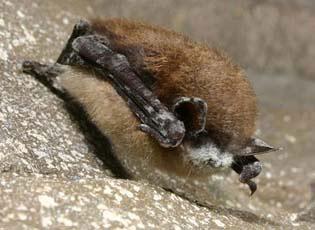Fungus, formerly known as Geomyces destructans is now known as Pseudogymnoascus destructans, or Pd. (Minnis and Lindner 2013)
White-Nose Syndrome (WNS)
Europe (Leopardi et al. 2015)
First detected in Albany County, New York in 2007, but the earliest evidence of the disease is from February 2006 in Schoharie County, New York (Hoyt et al. 2021)
Most likely introduced by human activity, possibly by a visitor to a show cave in New York. (Leopardi et al. 2015; Puechmaille et al. 2011)
Disease of bats causing a population decline of 72 to 88 percent of hibernating species in the northeastern U.S. (Lorch et al. 2012; Puechmaille et al. 2011)

White-nose syndrome, little brown bat with fungus on muzzle
Al Hicks, New York Department of Environmental Conservation
Find more images
Spotlights
Distribution / Maps / Survey Status
Videos
All Resources
Selected Resources
The section below contains highly relevant resources for this species, organized by source.
Council or Task Force
Partnership
Federal Government
International Government
State and Local Government
Academic
Hoyt, J.R., A.M. Kilpatrick, and K.E. Langwig. 2021. Ecology and impacts of white-nose syndrome on bats. Nature Reviews Microbiology 19:196–210.
Leopardi, S., D. Blake, and S.J. Puechmaille. 2015. White-Nose Syndrome fungus introduced from Europe to North America. Current Biology 25(6):R217-R219.
Lorch, J.M., L.K. Muller, R.E. Russell, M. O'Connor, D.L. Lindner, and D.S. Blehert. 2012. Distribution and environmental persistence of the causative agent of white-nose syndrome, Geomyces destructans, in bat hibernacula of the eastern United States. Applied and Environmental Microbiology 79(4):1293-1301.
Minnis, A.M. and D. L. Lindner. 2013. Phylogenetic evaluation of Geomyces and allies reveals no close relatives of Pseudogymnoascus destructans, comb. nov., in bat hibernacula of eastern North America. Fungal Biology 117(9):638–649.
Puechmaille, S.J., W.F. Frick, T.H. Kunz, P.A. Racey, C.C. Voigt, G. Wibbelt, and E.C. Teeling. 2011. White-nose syndrome: is this emerging disease a threat to European bats? Trends in Ecology and Evolution 26(11):570-576.
 An official website of the United States government.
An official website of the United States government.